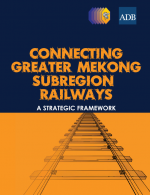
Connecting Greater Mekong Subregion Railways: A Strategic Framework
This strategic framework develops a practical approach to railway integration in the Greater Mekong Subregion, provides GMS countries with an initial framework for achieving integration and interoperability, identifies priority initiatives, builds a platform for further dialogue and discussion between and among GMS countries, and provides a context for evaluating future projects.






